
Modification : etheno dA
Catalog Reference Number
Category
Modification Code
5 Prime
3 Prime
Internal
Molecular Weight (mw)
Extinction Coeficient (ec)
Technical Info (pdf)
Absorbance MAX
Emission MAX
Absorbance EC
| Catalog No | Scale | Price |
| 26-6506-05 | 50 nmol | $255.00 |
| 26-6506-02 | 200 nmol | $255.00 |
| 26-6506-01 | 1 umol | $352.00 |
| 26-6506-03 | 2 umol | $632.00 |
| 26-6506-06 | 5 umol | $1,584.00 |
| 26-6506-10 | 10 umol | $2,814.00 |
| 26-6506-15 | 15 umol | $3,518.00 |
1,N-6 etheno deoxyadenosine (Etheno-dA) is a highly fluorescent derivative of dA, and can be incorporated at any position(s) within a DNA or RNA oligonucleotide. Etheno-dA has excitation maxima at 270 nm and 300 nm, and an emission maximum at 410 nm. Selective introduction of etheno-dA into DNA or RNA oligonucleotides is particularly useful in various structure-function studies of RNA, protein-RNA complexes, and DNA-RNA based diagnostics applications (1). However, because etheno-dA does not base-pair with dT or dU, oligos containing etheno-dA at either the 3’-end or in the middle will not function as either a sequencing or PCR primer. Etheno-dA-modified primers must have the modification(s) located either at or close to the 5’-end in order to so function (1).
Etheno-dA-modified oligonucleotides have proven particularly useful in the study of the repair of alkylated DNA damage by the base-excision-repair (BER) mechanism For example, such modified oligos were used to elucidate the function of N-methylpurine DNA glycosylase (2), as well as providing insights into how this BER enzyme facilitates resistance of astrocyte brain tumors (malignant astrocytomas) to DNA-alkylation-based chemotherapy agents (such as nitrosoureas) (3). Exocyclic etheno DNA adducts likely play an important role in carcinogenesis in both rodents and humans (4), and etheno-dA-modified oligonucleotides can be used as research tools for the study of carcinogenesis in various tissues.
References
1. Srivastava, S.C., Raza, S.K., Misra, R. 1,N6-etheno deoxy and ribo adenoGine and 3,N4-etheno deoxy and ribo cytidine phosphoramidites. Strongly fluorescent structures for selective introduction in defined sequence DNA and RNA molecules.
Nucleic Acids Res. (1994),
22: 1296-1304.
2. Dosanjh, M.K., Roy, R., Mitra, S., Singer, B. 1, N6-ethenoadenine is preferred over 3-methyladenine as substrate by a cloned human N-methylpurine-DNA glycosylase (3-methyladenine-DNA glycosylase).
Biochemistry (1994),
33: 61624-1628.
3. Harrison, J.F., Rinne, M.L., Kelley, M.R., Druzhyna, N.M., Wilson, G.L., Ledoux, S.P. Altering DNA Base Excision Repair: Use of Nuclear and Mitochondrial-Targeted N-Methylpurine DNA Glycosylase to Sensitize Astroglia to Chemotherapeutic Agents.
Glia. (2007),
55: 1416-1425.
4. Chung, F-L., Chen, H-J.C., Nath, R.G. Lipid peroxidation as a potential endogenous source for the formation of exocyclic DNA adducts.
Carcinogenesis (1996),
17: 2105-2111.
- etheno dexoyadenosine dA
